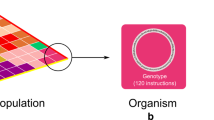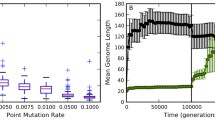Abstract
Darwinian evolution favours genotypes with high replication rates, a process called ‘survival of the fittest’. However, knowing the replication rate of each individual genotype may not suffice to predict the eventual survivor, even in an asexual population. According to quasi-species theory, selection favours the cloud of genotypes, interconnected by mutation, whose average replication rate is highest1,2,3,4,5. Here we confirm this prediction using digital organisms that self-replicate, mutate and evolve6,7,8,9. Forty pairs of populations were derived from 40 different ancestors in identical selective environments, except that one of each pair experienced a 4-fold higher mutation rate. In 12 cases, the dominant genotype that evolved at the lower mutation rate achieved a replication rate >1.5-fold faster than its counterpart. We allowed each of these disparate pairs to compete across a range of mutation rates. In each case, as mutation rate was increased, the outcome of competition switched to favour the genotype with the lower replication rate. These genotypes, although they occupied lower fitness peaks, were located in flatter regions of the fitness surface and were therefore more robust with respect to mutations.



Similar content being viewed by others
References
Eigen, M. Self-organization of matter and the evolution of biological macromolecules. Naturwissenschaften 58, 465–523 (1971).
Eigen, M. & Schuster, P. The Hypercycle: A Principle of Natural Self-Organization (Springer, Berlin, 1979).
Schuster, P. & Swetina, J. Stationary mutant distributions and evolutionary optimization. Bull. Math. Biol. 50, 636–660 (1988).
Eigen, M., McCaskill, J. & Schuster, P. The molecular quasi-species. Adv. Chem. Phys. 75, 149–263 (1989).
Nowak, M. A. What is a quasi-species? Trends Ecol. Evol. 7, 118–121 (1992).
Ray, T. S. in Artificial Life II (eds Langton, C. G., Taylor, C., Farmer, J. D. & Rasmussen, S.) 372–408 (Addison-Wesley, Redwood City, 1991).
Adami, C. Introduction to Artificial Life (Springer, New York, 1998).
Lenski, R. E., Ofria, C., Collier, T. C. & Adami, C. Genome complexity, robustness and genetic interactions in digital organisms. Nature 400, 661–664 (1999).
Adami, C., Ofria, C. & Collier, T. C. Evolution of biological complexity. Proc. Natl Acad. Sci. USA 97, 4463–4468 (2000).
Gerrish, P. J. & Lenski, R. E. The fate of competing beneficial mutations in an asexual population. Genetica 102/103, 127–144 (1998).
De Visser, J. A. G. M., Zeyl, C. W., Gerrish, P. J., Blanchard, J. L. & Lenski, R. E. Diminishing returns from mutation supply rate in asexual populations. Science 283, 404–406 (1999).
Taddei, F. et al. Role of mutator alleles in adaptive evolution. Nature 387, 700–702 (1997).
Sniegowski, P. D., Gerrish, P. J. & Lenski, R. E. Evolution of high mutation rates in experimental populations. of E. coli. Nature 387, 703–705 (1997).
Johnson, T. The approach to mutation–selection balance in an infinite asexual population, and the evolution of mutation rates. Proc. R. Soc. Lond. B 266, 2389–2397 (1999).
Waddington, C. H. Canalization of development and genetic assimilation of acquired characters. Nature 183, 1654–1655 (1959).
Nowak, M. A., Boerlijst, M. C., Cooke, J. & Maynard Smith, J. Evolution of genetic redundancy. Nature 388, 167–171 (1997).
Wagner, G. P., Booth, G. & Bagheri-Chaichian, H. A population genetic theory of canalization. Evolution 51, 329–347 (1997).
Freeland, S. J. & Hurst, L. D. Load minimization of the genetic code: history does not explain the pattern. Proc. R. Soc. Lond. B 265, 2111–2119 (1998).
Burch, C. L. & Chao, L. Evolvability of an RNA virus is determined by its mutational neighbourhood. Nature 406, 625–628 (2000).
van Nimwegen, E., Crutchfield, J. P. & Huynen, M. Neutral evolution of mutational robustness. Proc. Natl Acad. Sci. USA 96, 9716–9720 (1999).
Wike, C. O. Adaptive evolution on neutral networks. Bull. Math. Biol. (in the press).
Haldane, J. B. S. The effect of variation on fitness. Am. Nat. 71, 337–349 (1937).
Muller, H. J. Our load of mutations. Am. J. Hum. Genet. 2, 111–176 (1950).
Charlesworth, B. Mutation–selection balance and the evolutionary advantage of sex and recombination. Genet. Res. 55, 199–221 (1990).
Drake, J. W. Rates of spontaneous mutation among RNA viruses. Proc. Natl Acad. Sci. USA 90, 4171–4175 (1993).
Drake, J. W., Charlesworth, B., Charlesworth, D. & Crow, J. W. Rates of spontaneous mutation. Genetics 148, 1667–1686 (1998).
Eyre-Walker, A. & Keightley, P. D. High genomic deleterious mutation rates in hominids. Nature 397, 344–347 (1999).
Lynch, M. et al. Spontaneous deleterious mutation. Evolution 53, 645–663 (1999).
Acknowledgements
This work was supported by the National Science Foundation. Part of this work as carried out at the Jet Propulsion Laboratory, under a contract with the National Aeronautics and Space Administration. J.L.W. acknowledges the support of an Axline SURF fellowship.
Author information
Authors and Affiliations
Corresponding author
Supplementary information
Rights and permissions
About this article
Cite this article
Wilke, C., Wang, J., Ofria, C. et al. Evolution of digital organisms at high mutation rates leads to survival of the flattest. Nature 412, 331–333 (2001). https://doi.org/10.1038/35085569
Received:
Accepted:
Issue Date:
DOI: https://doi.org/10.1038/35085569
- Springer Nature Limited
This article is cited by
-
Ontology for the Avida digital evolution platform
Scientific Data (2023)
-
Complex dynamics in a synchronized cell-free genetic clock
Nature Communications (2022)
-
An interplay of resource availability, population size and mutation rate potentiates the evolution of metabolic signaling
BMC Ecology and Evolution (2021)
-
Moderate Amounts of Epistasis are Not Evolutionarily Stable in Small Populations
Journal of Molecular Evolution (2020)
-
Evolution of Epistasis: Small Populations Go Their Separate Ways
Journal of Molecular Evolution (2020)





